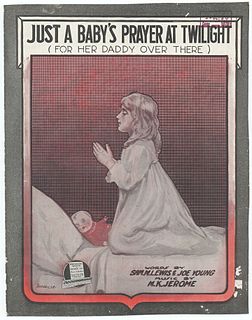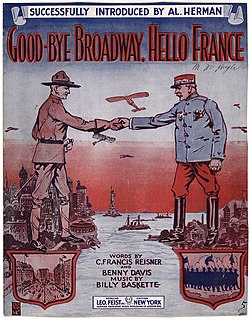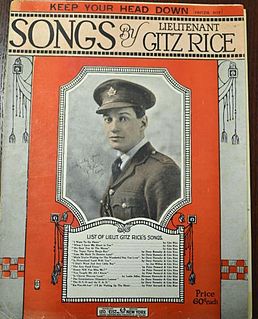
"K-K-K-Katy" is a World War I-era song written by Canadian American composer Geoffrey O'Hara in 1917 and published in 1918. The sheet music advertised it as "The Sensational Stammering Song Success Sung by the Soldiers and Sailors", as well as "The Sensational New Stammering Song" The song was first played at a garden party fund-raiser for the Red Cross in Collins Bay on Lake Ontario. O'Hara was from Chatham, Ontario, and taught music at several universities.

"Somewhere In France Is the Lily" is a World War I march composed in 1918 by Joseph E. Howard with lyrics written by Philander Chase Johnson. It became a hit twice in 1918, charting when released by Charles Hart and by Henry Burr. The song presents a young couple separated by war but held together by love and the sentimental value of lily flowers.

"They Were All Out of Step But Jim" is an American World War I war song. It rose to popularity in 1918 when released by Billy Murray, charting at #3 in the United States.

"Au Revoir, but not Good Bye: Soldier Boy" is a 1917 song composed by Albert von Tilzer, with lyrics written by Lew Brown.

Just a Baby's Prayer at Twilight is a 1918 song composed by M.K. Jerome, with lyrics written by Sam M. Lewis and Joe Young. The song was published by Waterson, Berlin & Snyder Co. The song was performed by Henry Burr and reached number one on the top 100 US songs of 1918. Burr's recording sold a million copies in sheet music and sales.

Oui, Oui, Marie is a 1918 song composed by Fred Fisher with lyrics written by Alfred Bryan and Joe McCarthy. It was published by McCarthy & Fisher Inc. The sheet music cover featured an illustration by Andre De Takacs. The song was in the top 20 charts from September 1918 to February 1919 and reached number 10 in December. It was recorded by Arthur Fields, Irving Kaufman, and Rachel Grant & Billy Murray. The sheet music can be found at the Pritzker Military Museum & Library.

Good-Bye Broadway, Hello France is a 1917 song composed by Billy Baskette, with lyrics written by C. Francis Reisner and Benny Davis. The song was published by Leo Feist, Inc.

"My Belgian Rose" is a 1918 song written by George Benoit, Robert Levenson, and Ted Garton, and published by Leo Feist, Inc. The song was performed by Charles Hart and Ellot Shaw and reached number eight on the top 100 U.S. songs of 1918.

When I Send You a Picture of Berlin: You'll Know It's Over, Over There is a World War I song written and composed by Frank Fay, Ben Ryan and Dave Dreyer. Written for voice and piano, this song was published in 1918 by Harry Von Tilzer Music Publishing Co., in New York, NY. The cover, illustrated by Pfeiffer Illustrating Co., depicts a soldier with a camera while in the background the cavalry rides through a monument. The song was recorded by Arthur Fields & the Peerless Quartet.
"Lafayette " is a World War I song written and composed by Mary Earl, which was a pseudonym of Robert A. King. It was published in New York, New York by Shapiro, Bernstein, & Co. in 1918. The sheet music cover, illustrated by Albert Barbelle, depicts soldiers marching with fixed bayonets below a statue of Lafayette in silhouette.
"Good-bye France " is a World War I song written by Irving Berlin. It was published in 1918 by Waterson, Berlin & Snyder, Inc., in New York City. The sheet music cover, illustrated by Albert Wilfred Barbelle, features French and American soldiers shaking hands with the Statue of Liberty in the background.

"I'm Proud to Be the Sweetheart of a Soldier" is a World War I song written and composed by Mary Earl. This song was published in 1918 by Shapiro, Bernstein & Co. Inc., in New York City. The sheet music cover, illustrated by E. E. Walton, depicts a young woman in a sailor outfit holding a picture of a soldier.

"Giddy Giddap! Go On! Go On! We're On Our Way to War" is a World War I song written and composed by Jack Frost. This song was published in 1917 by Frank K. Root & Co., in Chicago, Illinois. The sheet music cover depicts a mule pulling four soldiers in a wagon.

"Keep Your Head Down, Fritzie Boy" is a World War I song written and composed by Gitz Rice. This song was published in 1918 by Leo. Feist, Inc., in New York, NY. The cover features a photo of Gitz Rice and reads "inspired by a brave Tommy and written at the Battle of Ypres, 1915."
"Give a Little Credit to the Navy" is a World War I song written by Buddy DeSylva & Gus Kahn and composed by Albert Gumble. This song was published in 1918 by Jerome H. Remick & Co., in Detroit, MI.

Send Me Away With A Smile is a World War I song written by Louis Weslyn and composed by Al Piantadosi. The song was first published in 1917 by Al. Piantadosi & Co., Inc. in New York, NY. The sheet music cover depicts a woman waving to a soldier from a fenced yard with an inset photo of Rita Gould.

"The Russians Were Rushin', the Yanks Started Yankin'" is a World War I song written by Carey Morgan and composed by Charles R. McCarron. The song was first published in 1918 by Broadway Music Corporation in New York City. The sheet music cover depicts an elderly man smoking a pipe with silhouetted soldiers across the top and bottom.
"Three Wonderful Letters from Home" is a World War I song written by Ballard MacDonald & Joe Goodwin and composed by James F. Hanley. The song was first published in 1918 by Shapiro, Bernstein & Co., in New York City. The sheet music cover, illustrated by Albert Wilfred Barbelle, depicts a mother, wife, and daughter writing letters with marching troops and a plane, ship, and tank in the background.
Uncle Sam and His Battering Ram is a World War I song written by Robert P. Hall and composed by Ida K. Mervine. The song was first published in 1918 by Mervine & Hall Music in Phoenix, AZ. The sheet music cover features Uncle Sam pointing to the Kaiser as a ram butts him in the stomach.
When the Flowers Bloom On No-Man's Land is a World War I song written by Howard E. Rogers and composed by Archie Gottler. The song was first published in 1918 by Kalmar, Puck, & Abrahams Music Co., in New York, NY. The sheet music cover depicts soldiers marching with an inset photo of Fred Weber. The sheet music was later reprinted with an inset photo of Dorothy Jarrett.














